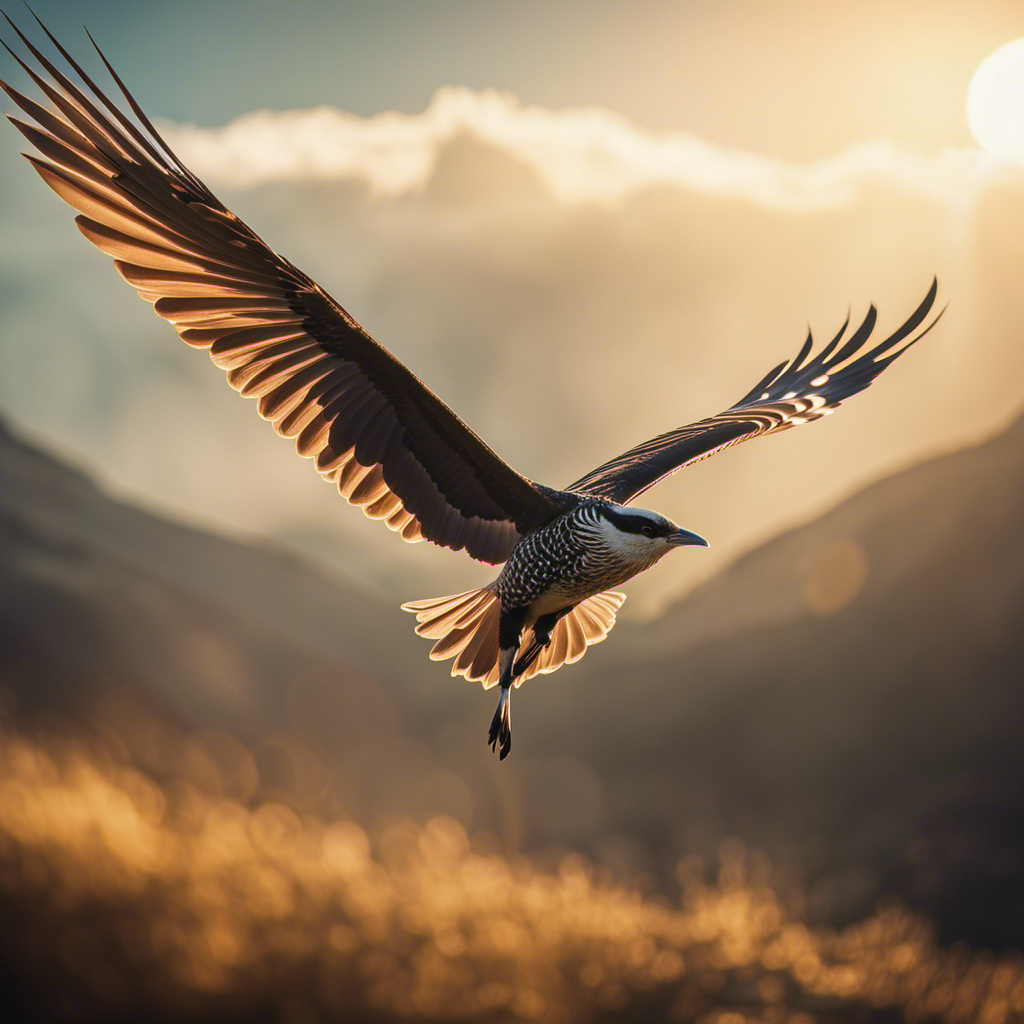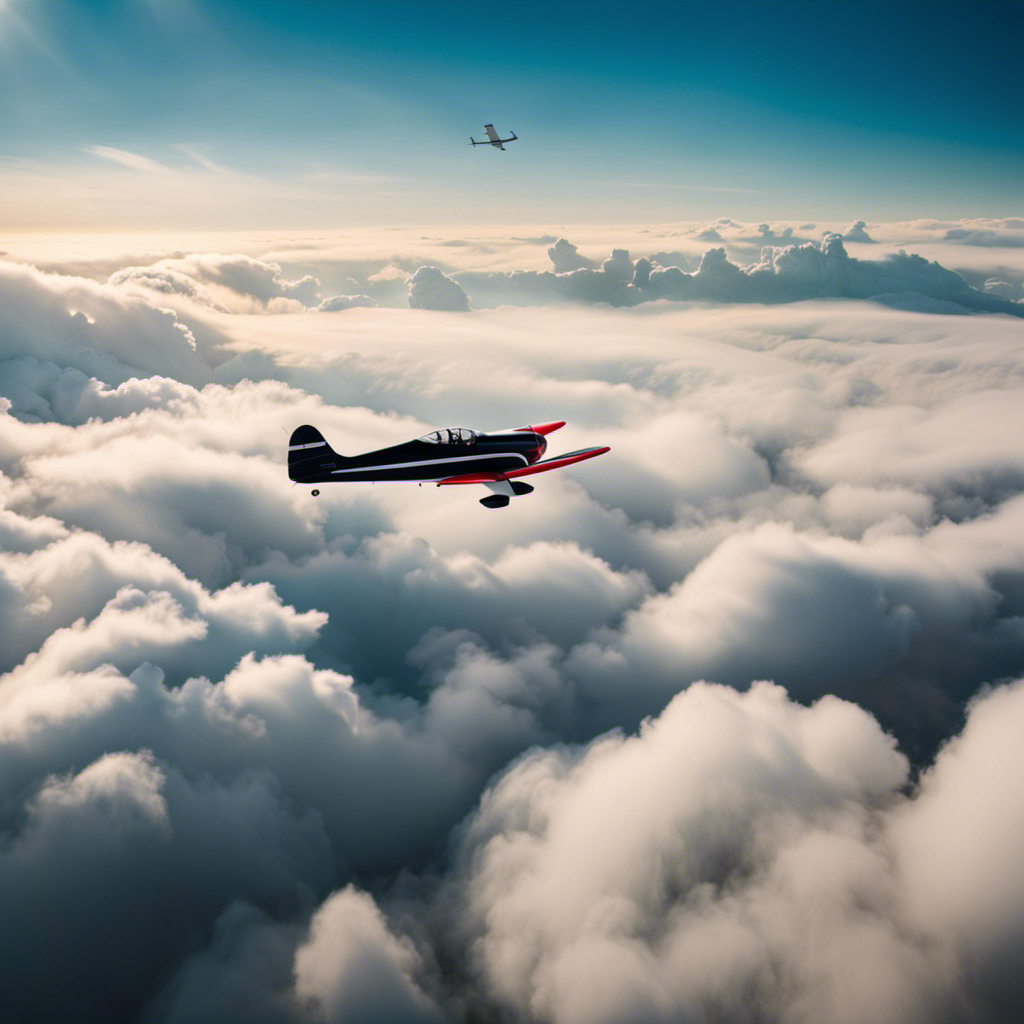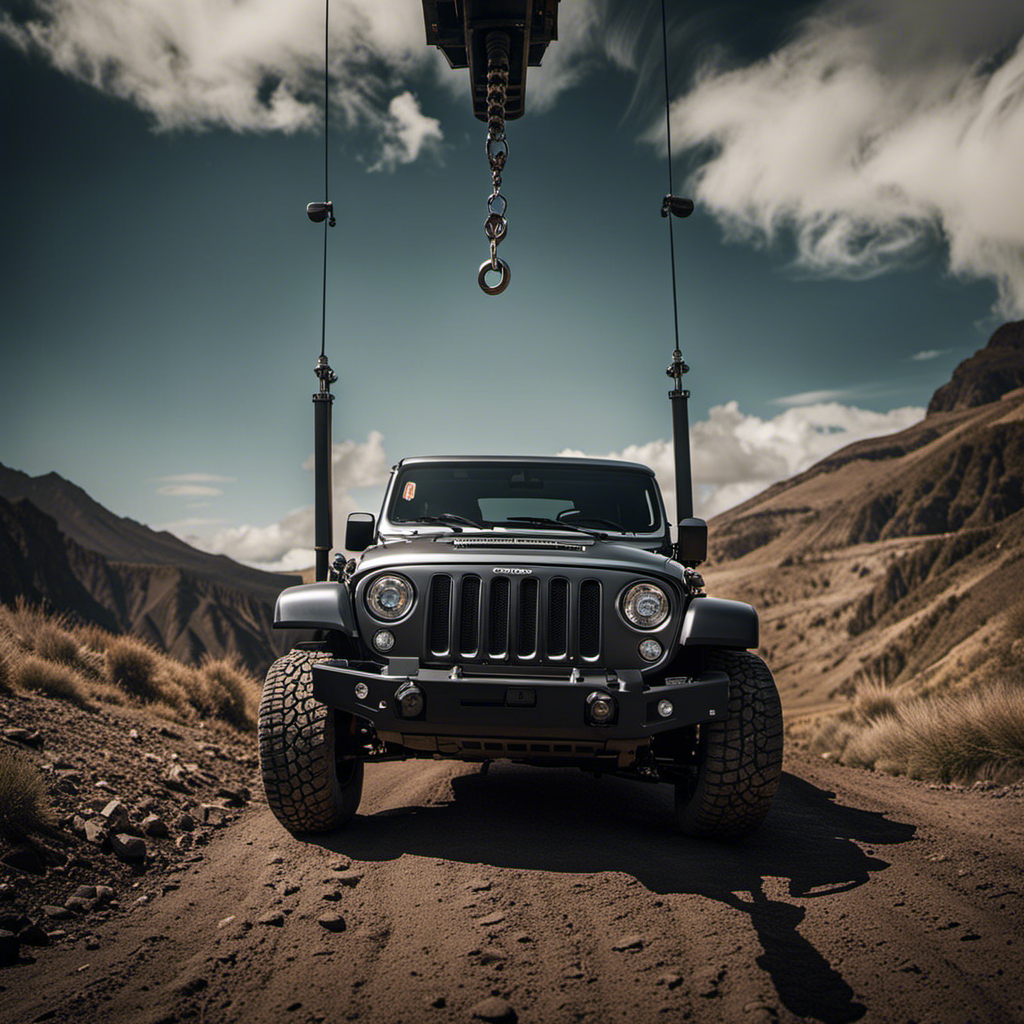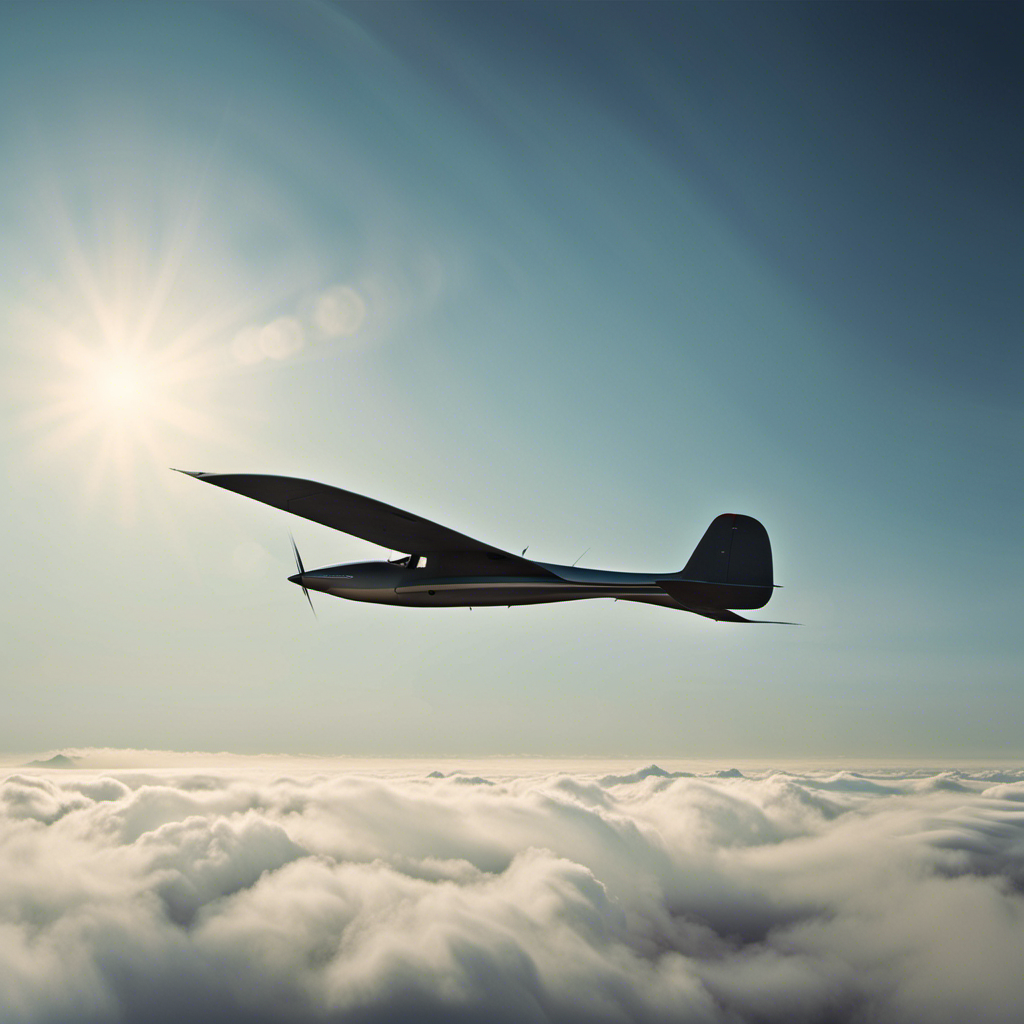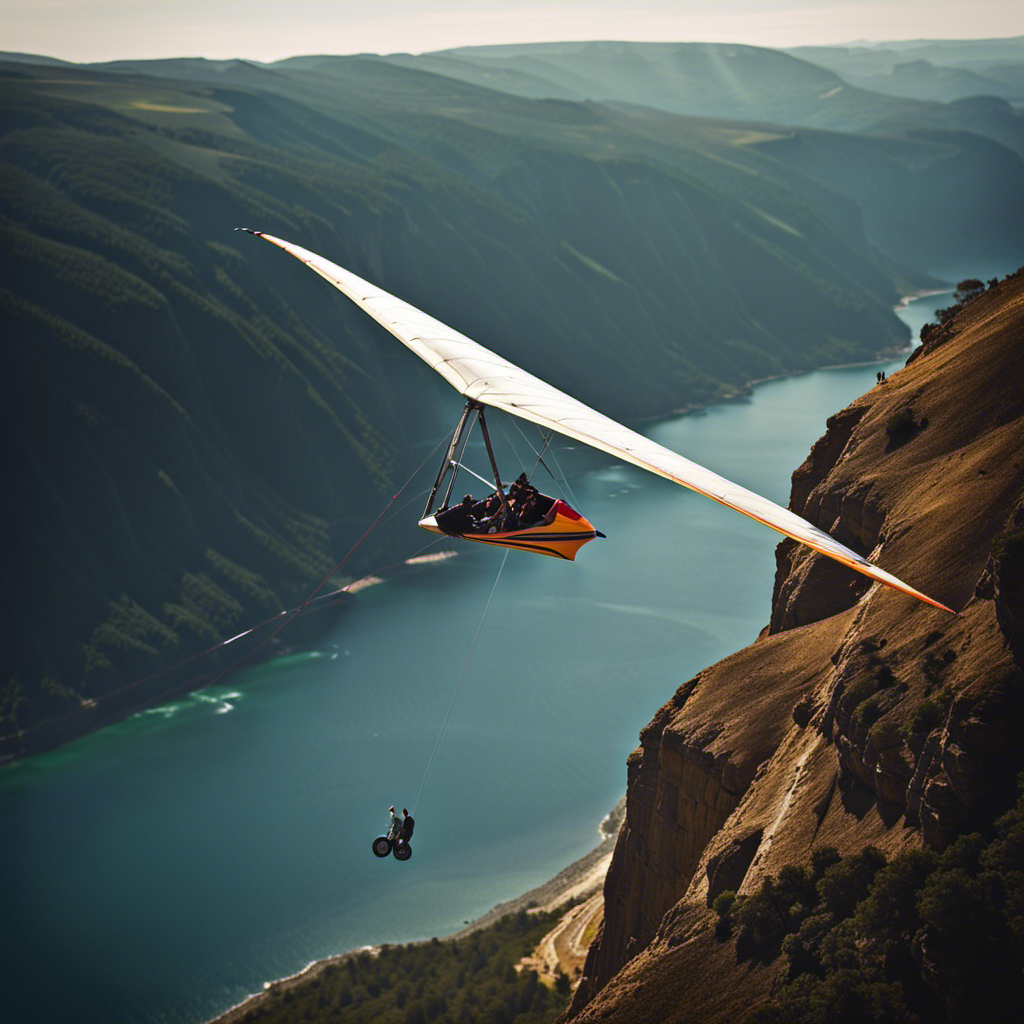Have you ever wondered about those incredible creatures that effortlessly glide through the sky? Well, get ready, because you’re in for a treat, my friend.
In this article, we’ll delve into the fascinating world of soaring birds and unravel the secrets behind their graceful flight. From the mechanics of flight to their geographic distribution and migration patterns, we’ll leave no stone unturned.
So grab your binoculars and get ready to embark on an awe-inspiring journey into the realm of these magnificent aviators.
Key Takeaways
- Soaring birds undertake seasonal migration between breeding and wintering grounds.
- They navigate using wind patterns and thermals.
- Soaring birds rely on keen eyesight to spot prey.
- Soaring birds have unique adaptations for extended flight.
Understanding Soaring Birds
Soaring birds, like hawks and eagles, use rising air currents to effortlessly glide through the sky. These magnificent creatures have adapted to take advantage of the natural forces in their environment.
By relying on thermals, updrafts, and ridge lift, they can stay aloft for extended periods without expending much energy. Thermals are columns of warm air that rise from the ground, created by the heating of the Earth’s surface. Updrafts occur when wind encounters an obstacle, such as a mountain, and is forced to rise. Ridge lift occurs when wind blows against a slope and is deflected upwards.
Soaring birds have evolved to master the art of finding and utilizing these air currents, allowing them to cover great distances and conserve energy. Understanding the mechanics of flight is essential to comprehend how these birds navigate the skies with such grace and efficiency.
The Mechanics of Flight
Flying at high altitudes requires birds to utilize specific mechanics to maintain stability and maneuverability. As a soaring bird, you possess remarkable adaptations that allow you to effortlessly glide through the sky.
Here are some of the mechanics that make your aerial feats possible:
-
Wingspan: Your expansive wingspan, often spanning several feet, provides you with the lift necessary to stay aloft for extended periods.
-
Wing shape: Your wings are broad and flat, allowing you to catch the air currents and generate lift efficiently.
-
Wing loading: Your lightweight body and sturdy wings allow you to float effortlessly on the wind, conserving energy for long journeys.
-
Wingtip slots: These specialized slots on your wingtips enhance your agility and reduce turbulence, enabling precise control during flight.
Now, let’s explore the fascinating world of soaring birds and discover the various types that grace the skies with their aerial prowess.
Types of Soaring Birds
Among the different types of soaring birds, one particularly impressive species is the albatross. With its immense wingspan, the albatross is perfectly adapted for soaring effortlessly for long periods of time. It possesses a unique combination of physical characteristics that enable it to glide through the air with ease. The albatross has long, narrow wings that allow it to catch air currents and stay aloft for extended periods. Its streamlined body minimizes drag, further enhancing its flight capabilities. Additionally, the albatross has strong muscles and a lightweight skeleton, enabling it to navigate the skies with agility. To illustrate the remarkable features of the albatross, refer to the following table:
| Physical Characteristics | Adaptations | Flight Abilities |
|---|---|---|
| Long, narrow wings | Air current capture | Extended flight duration |
| Streamlined body | Reduced drag | Agile aerial maneuvers |
| Strong muscles | Efficient propulsion | Precision control |
These features make the albatross an exceptional soaring bird, capable of traversing vast distances with minimal effort. Transitioning to the subsequent section about geographic distribution, it is important to consider how the albatross utilizes its flight abilities to navigate and inhabit different regions of the world.
Geographic Distribution
To understand the geographic distribution of these incredible creatures, you should consider the various regions of the world that the albatross inhabits.
Albatrosses are found primarily in the Southern Ocean, with the majority of their breeding colonies located on remote islands such as South Georgia, the Falkland Islands, and the Crozet Islands. These islands provide the perfect nesting grounds for these majestic birds, offering protection from land predators and abundant food sources from the surrounding waters.
The Southern Ocean is home to the largest populations of albatrosses, with over 20 species inhabiting this region. Some albatross species also venture into the North Pacific Ocean, particularly around the coast of Alaska and the Bering Sea. The Indian Ocean and the South Atlantic Ocean also host several albatross species, although their numbers are lower compared to the Southern Ocean.
Understanding the albatross’s geographic distribution is crucial in studying their migration patterns, which will be explored in the following section.
Migration Patterns
When it comes to migration patterns, you’ll find that many soaring birds engage in long-distance migration, traveling thousands of kilometers from their breeding grounds to their wintering grounds. This allows them to take advantage of favorable conditions for feeding and breeding throughout the year.
These birds also exhibit seasonal migration, moving between their breeding and wintering grounds in a predictable pattern, often following specific routes and stopping at specific sites along the way. Understanding these migratory routes and the factors that influence them is crucial for the conservation and management of these magnificent creatures.
Long-Distance Migration
Soaring birds can travel thousands of miles during their long-distance migrations. These remarkable creatures possess unique adaptations that allow them to cover vast distances in search of suitable habitats and resources.
Here are four fascinating aspects of their long-distance migrations:
-
Navigation: Soaring birds have an exceptional ability to navigate using a combination of visual cues, magnetic fields, and celestial cues. They can accurately detect their precise location and determine the optimal route to their destination.
-
Energy conservation: To sustain their long flights, soaring birds employ energy-saving techniques such as utilizing thermal updrafts and ridge soaring. By exploiting rising air currents, they can minimize their expenditure of energy and cover greater distances.
-
Stopover sites: During their journey, soaring birds rely on strategically located stopover sites where they rest and replenish their energy reserves. These sites provide essential resources like food and water, allowing them to continue their migration.
-
Migration routes: Soaring birds follow specific migration routes, often known as flyways, which are well-established pathways that connect their breeding and wintering grounds. These routes ensure the birds can efficiently navigate across diverse landscapes and avoid geographical barriers.
Long-distance migration is an extraordinary phenomenon in the lives of soaring birds. It is an essential part of their annual cycle and serves as a prelude to the subsequent section on seasonal migration.
Seasonal Migration
As you learned in the previous section, long-distance migration is a remarkable feat that some soaring birds undertake.
Now, let’s delve into another fascinating aspect of their migratory behavior: seasonal migration.
Seasonal migration refers to the regular movement of soaring birds between breeding and wintering grounds, which can occur over shorter distances compared to long-distance migration.
These movements are driven by changes in environmental conditions, such as food availability and temperature.
During the breeding season, soaring birds inhabit regions with abundant resources and favorable nesting conditions. However, as winter approaches and these resources dwindle, they embark on their seasonal migration to more favorable wintering grounds.
This cyclic movement allows them to optimize their chances of survival and reproductive success throughout the year.
Understanding the patterns and routes of their seasonal migration can provide valuable insights into the ecological needs and conservation of these majestic creatures.
Migratory Routes
To better understand the migratory routes of these majestic creatures, you can study their patterns and routes of seasonal migration. Soaring birds are known for their incredible ability to cover vast distances during their migrations. They navigate through diverse landscapes, utilizing the prevailing wind patterns and thermals to their advantage.
These birds follow specific routes that have been shaped by generations of instinct and learning. Some species, like the osprey, embark on transcontinental journeys, crossing entire continents and even oceans. Others, such as the golden eagle, migrate along mountain ranges, taking advantage of updrafts and thermals created by the terrain.
Feeding Habits
Birds that soar in the sky, such as eagles and vultures, rely on their keen eyesight to spot potential prey. These magnificent creatures have evolved to be expert hunters, with specialized adaptations that allow them to efficiently locate and capture their food. They have a wide field of vision and can see small details from great distances. To showcase their feeding habits, let’s take a closer look at a few examples of soaring birds:
| Bird | Prey |
|---|---|
| Bald Eagle | Fish, small mammals, waterfowl |
| Golden Eagle | Rabbits, hares, rodents, snakes |
| Turkey Vulture | Carrion, dead animals |
These birds employ different hunting strategies and have adapted to feed on a variety of prey. Their ability to soar provides them with a distinct advantage, allowing them to scan large areas for potential meals. With their powerful eyesight, they can spot the slightest movement or unusual behavior that signals the presence of prey. This remarkable hunting ability is a testament to the incredible adaptations of soaring birds.
Transitioning into the next section about ‘social behavior,’ these birds not only excel in hunting but also display fascinating interactions with their own kind.
Social Behavior
Now that you understand the feeding habits of soaring birds, let’s delve into their intriguing social behavior.
These majestic creatures are not solitary beings; they often form close-knit communities within their species. Soaring birds, such as vultures and hawks, exhibit a complex social structure that revolves around a hierarchical system. Within these societies, dominant individuals establish their authority and maintain control over resources, including food and nesting sites.
Subordinate birds abide by a set of rules, displaying submissive behaviors to avoid conflict and maintain harmony within the group. Social interactions among soaring birds include courtship displays, cooperative hunting, and communal roosting.
These social bonds are crucial for their survival, as they facilitate the sharing of information and resources. Understanding the social dynamics of soaring birds is essential for their conservation and management. By studying their social behavior, scientists can develop strategies to protect these remarkable creatures and mitigate the threats they face in their natural habitats.
Threats and Conservation
Understanding the threats to the conservation of these magnificent creatures is imperative for their long-term survival. Soaring birds, with their ability to effortlessly glide through the air, face numerous challenges in their quest for existence.
• Habitat loss: The destruction of their natural habitats, such as deforestation and urbanization, restricts their ability to find suitable nesting and foraging grounds.
• Climate change: Alterations in weather patterns and rising temperatures can affect food availability and disrupt migration patterns, impacting the survival of these birds.
• Human disturbance: Activities like hunting, pollution, and collisions with power lines and wind turbines pose significant threats to soaring birds.
• Illegal trade: The illegal capture and trade of these birds for falconry, traditional medicine, or the pet trade contribute to their decline.
These creatures, despite their remarkable adaptations, are facing an uphill battle against these challenges. However, by understanding these threats and taking necessary conservation measures, we can ensure the survival of these awe-inspiring creatures.
As we move into the next section, let’s explore some famous soaring birds and their remarkable abilities.
Famous Soaring Birds
As you delve into this section, you’ll be amazed by the remarkable abilities of some well-known birds that glide effortlessly through the air. Soaring birds have developed unique adaptations that allow them to stay aloft for extended periods of time, harnessing the power of rising air currents. Let’s take a closer look at three famous soaring birds and their impressive abilities:
| Bird Name | Wingspan | Habitat |
|---|---|---|
| Golden Eagle | 6-7 feet | Mountains |
| Albatross | 6-11 feet | Open ocean |
| Red-tailed Hawk | 4-5 feet | Open fields |
The Golden Eagle, with its broad wingspan of 6-7 feet, is masterful at riding thermal updrafts in mountainous regions. Albatrosses, boasting wingspans of 6-11 feet, gracefully soar over the open ocean, using a technique called dynamic soaring. Red-tailed Hawks, with wingspans of 4-5 feet, can be found soaring above open fields, effortlessly utilizing thermals and updrafts. These birds are true masters of the sky, and observing their flight patterns can be a thrilling experience for any birdwatcher.
Now that you have learned about the incredible abilities of soaring birds, let’s move on to the next section, where you will discover some helpful tips for birdwatching.
Tips for Birdwatching
To enhance your birdwatching experience, try using a pair of binoculars to get up-close views of the feathered creatures. Binoculars allow you to observe birds in their natural habitat without disturbing them.
Here are some tips to make the most of your birdwatching adventures:
-
Find a good spot: Look for areas with diverse habitats, such as forests, wetlands, or meadows, as they attract a wide variety of bird species.
-
Be patient: Birds can be elusive, so it’s important to be patient and observe quietly. Avoid sudden movements and loud noises that could scare them away.
-
Use field guides: Carry a field guide to help you identify different bird species based on their physical characteristics, behavior, and habitat preferences.
-
Take notes: Keep a journal to record your observations, including the date, time, location, and any notable behaviors or features. This will help you track your progress and learn more about the birds you encounter.
Frequently Asked Questions
How do soaring birds communicate with each other?
Soaring birds communicate with each other through various visual and vocal signals. They use body movements, such as wing flapping and gliding patterns, to convey messages. Vocalizations, including calls and songs, are also important for communication among soaring birds.
What are the main threats to soaring bird populations?
Soaring birds face various threats, including habitat loss, electrocution from power lines, collisions with wind turbines, and illegal hunting. These factors contribute to declining populations, highlighting the urgent need for conservation efforts.
Are there any specific conservation efforts in place to protect soaring bird species?
Yes, there are specific conservation efforts in place to protect soaring bird species. These efforts include habitat conservation, limiting human disturbance, implementing wind turbine guidelines, and conducting research to better understand their populations and behavior.
Are there any endangered or critically endangered soaring bird species?
Yes, there are several endangered or critically endangered soaring bird species, such as the California Condor, Philippine Eagle, and White-rumped Vulture. Conservation efforts are in place to protect and restore their populations.
Can soaring birds fly during the night or only during the day?
Soaring birds, such as eagles and vultures, are capable of flying both during the day and night. They have excellent vision and rely on thermals, or columns of rising warm air, to effortlessly glide through the sky.
Conclusion
In conclusion, understanding soaring birds is a fascinating endeavor. These magnificent creatures have mastered the art of flight, utilizing various techniques to stay aloft for hours without flapping their wings.
Did you know that some soaring birds can cover distances of up to 500 kilometers in a single day during migration? This astonishing statistic showcases their incredible endurance and navigational abilities.
By appreciating their geographic distribution, migration patterns, and social behavior, we can better appreciate these awe-inspiring creatures and work towards their conservation.
So grab your binoculars and explore the world of soaring birds through birdwatching!
